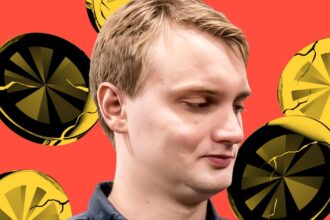After 15 years the greatest mystery in financial history is finally solved. Wallets linked to Satoshi have seen a resurgence in recent days. HBO Documentary Rekindles Speculation About Bitcoin's Origins
Anticipating mounting days, a documentary that aired on Tuesday claimed that Canadian software developer Peter Todd, the creator of Bitcoin, was the pseudonymous cypherpunk Satoshi Nakamoto.
But the evidence is unlikely to satisfy everyone who has long analyzed it, marshaled by filmmaker Cullen Hoback in “Money Electric: The Bitcoin Mystery,” three years after Nakamoto, who mysteriously disappeared in 2011, shared a bitcoin white paper on the P2P Foundation's website. .
Todd himself denied Hoback's claim in the documentary, calling it “ridiculous” and On X Tuesday evening.
Todd didn't answer right away NewsA request for comment was made Tuesday night.
Journalists and crypto sleuths have spent years trying to solve what may be the greatest mystery in modern finance: Who was Satoshi Nakamoto?
The usual suspects
Their efforts went by many names and some suggested that Nakamoto was a group of people. The usual suspects — Nick Szabo and Adam Back among them — denied they were Satoshi.
one 2014 report Satoshi Nakamoto is none other than the man of the same name who lives quietly and openly in Southern California. Speculation has also turned to X owner and multi-billionaire Elon Musk.
Craig Wright, an Australian computer scientist, tried and failed to prove he was Nakamoto in a lawsuit filed in the UK.
Join the community to get our latest articles and updates
In the documentary, Hoback Unearths a Leave a comment Todd did this on a Bitcoin forum in December 2010, in which he replied to one of Nakamoto's posts.
“Read this closely,” Hoback tells one of his colleagues in the film. “There is [Todd] Responding, David? Or is he pursuing an idea?”
Hoback positions Nakamoto and Todd as one and the same, and while using Satoshi Nakamoto's account Todd accidentally logs in using a recently created account under his own name to end the idea he shared an hour and a half earlier.
The filmmaker also points to other hints that it might be Todd Nakamoto, including that during the summer Nakamoto posted so often, “like they were on an academic calendar” — Todd was a university student in the early days of Bitcoin — and Nakamoto stopped posting. Forum shortly after Todd joined.
“I'll warn you, it's going to be very funny when you put it in a documentary and some Bitcoiners see it,” Todd said in the film.
“I suspect a lot of them would be very happy if you went down this route, because it's another example of journalists really missing the point.”
Hoback asks Todd to explain.
“The point is to make bitcoin a global currency,” Todd said, adding that Hoback and others trying to unravel Nakamoto were “distracted by the nonsense.”
But the question of Nakamoto's identity is more than idle speculation.
Bitcoin, introduced 15 years ago, the original cryptocurrency and the anchor of the crypto economy, is now worth $2.3 trillion.
Central banks are studying blockchain technology, Wall Street giants are funding bitcoin, and both candidates for US president in the November 5 election have mentioned crypto on the campaign trail.
$67 billion in reserves
Nakamoto is estimated to control 1.1 million bitcoins, worth about $67 billion at Tuesday's prices.
If Nakamoto has access to a bunch of bitcoins, this means that the creator could one day try to sell them, an event that could have a dramatic effect on the token's price.
For example, before the initial public offering in 2021, Coinbase stated that the identity of Nakamoto or the transfer of their Bitcoins could adversely affect its business.
Cryptographers Club
Nakamoto was an outspoken and frequent speaker in a group of mathematicians and cryptographers referred to as the Cypherpunk mailing list.
Members include WikiLeaks founder Julian Assange; Ross Ulbricht, founder of dark web marketplace Silk Road; and Vitalik Buterin, co-founder of Ethereum.
Nakamoto's communication on the mailing list was sudden stopped In December 2010. His last known email sent In April 2011.
Prior to the start of the documentary, Satoshi was betting on the polymarket pool about his identity The bet was made $20 million on various candidates.
The late American cryptographer Len Sassaman, once a pioneer of polymarket, fell out of favor with bettors on Monday. CNN He confronts Nakamoto in the documentary.
And said Sassaman's widow, Meredith Patterson News HBO never contacted her while making the documentary.
Bettors turned their attention to American polymath and computer scientist Nick Szabo. Yet by afternoon New York time his odds had also fallen. Suddenly, Adam Back, CEO of Blackstream, was the top candidate to be named, but many recognize Hoback as multiple creators or someone who is not among the 15 named candidates.
Szabo repeatedly says that he is not Satoshi.
But he was a member of the Cypherpunk mailing list, and before Nakamoto published the Bitcoin white paper he was known to have worked on what he called BitGold.
13 candidates
Additionally, a controversial 2014 study by Aston University's Center for Forensic Linguistics analyzed the writing style of 13 prominent Nakamoto candidates and said Szabos was close to the author of the Bitcoin white paper.
Bitcoin refers to White Paper Back's Hashcash Protocol and Wei Dai's B-Money. Back and Die are both members of the Cypherpunk mailing list.
Another longtime candidate is the late software developer Hal Finney.
Finney was the first to reply to the Bitcoin white paper, the first to download the software, and the second miner after Satoshi to verify transactions.
In 2009, Finney was diagnosed with ALS, an incurable motor neuron disease.
Some have speculated that Finny's health deteriorated when Satoshi disappeared from the web in 2011.
Finney denied in an interview that he was Satoshi Forbes Shortly before his death in 2014.
Old purses
Adding to the intrigue, more than a dozen early Bitcoin wallets have sprung back to life in the past week.
In recent months, these wallets, which were first active on the network between 2009 and 2010, have moved a combined $35 million to new addresses and crypto exchanges.
Generally, such movements do not attract significant attention. It is not uncommon for older wallets to occasionally move Bitcoin.
But the increased frequency of wallet movements, along with a documentary announcement focusing on Nakamoto's identity, added a fresh layer of intrigue.
Alex Gilbert News'Diffie correspondent from New York. You can reach him at [email protected].
Related TopicsBITCOIN







